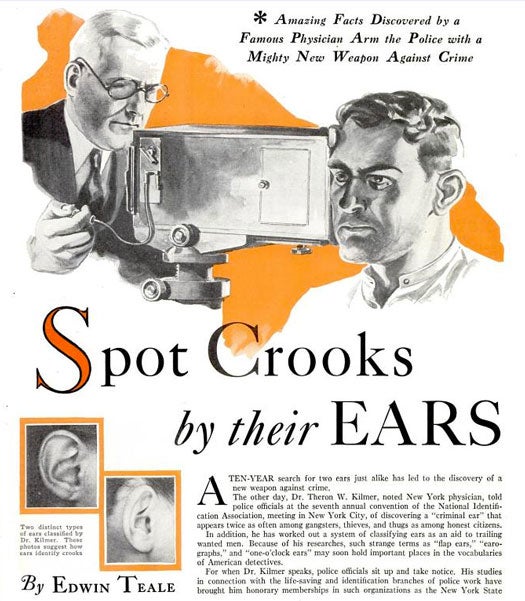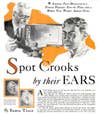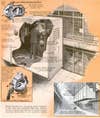There’s something timeless about a good detective story. At the end of a long day, it’s nice to know that the clues check out, the crooks get caught, and everyone goes home happy. During the early 1930s, Popular Science capitalized on the mystery genre by running a series of articles detailing how the modern detective incorporates science into crime detection. We were enthralled by scientists who could trace a bullet to its weapon simply by examining it under a microscope. We were thrilled that a person’s gender and age could be determined from a single strand of hair.
Nowadays, we’re so used to seeing forensics dramatized on TV that we take criminology for granted, but for a generation raised on Edgar Allan Poe, Sir Arthur Conan Doyle and Agatha Christie, these developments were nothing short of marvelous.
Like the first article in our series says, science has trumped Sherlock Holmes as the most trustworthy detective. It takes a clever man to detect circumstantial evidence, but a few damning clues can’t compare to solid proof that a week-old bloodstain comes from a particular person. To help our readers understand how the scientists glean knowledge from trace evidence, we visited experts like firearms identification pioneer Calvin Goddard, who used his helixometer, to show us how uses microscopic grooves to differentiate between bullets.
Sometimes we covered cases that were less violent. In a feature called “Hidden Crime Clues Bared by Chemist’s Magic,” we described how scientists could decode messages written in invisible ink by dipping them in various fluids. A couple of years later, police squads nationwide intercepted similar messages by using amphibian airplanes to trail carrier pigeons owned by the underworld. If that sounds a little quaint, you’ll laugh at archive gems like our feature that lauded earography, the science of identifying criminals by their ears.
As silly as it sounds, the earograph apparatus isn’t the strangest tool detectives-turned-scientists used during the early days of modern forensics.
Science, the New Sherlock Holmes: August 1931
In the early 1930s, we published a series of articles detailing how applied science thwarts criminals. To learn more about the latest in forensics, we visited the Scientific Crime Detection Laboratory in Chicago, where seasoned members of homicide squads learned how to use lie detectors, how to read fingerprints, and how to differentiate different particles of dust beneath a microscope lens. Old methods of methods of nabbing a confession, like confronting a suspect with circumstantial evidence, had been replaced by heartbeat monitors and bloodstain analysis. Forensics breakthroughs occurred in cases like the one where a bank robber filed through a lock, only to be apprehended once authorities determined that the dust on his trouser cuffs matched the metal alloy used in the lock.
Introducing the Black Light: October 1931
When faced with the challenge of authenticating counterfeit materials, police hailed black lights as their greatest advantage in catching crooks. We explained that when struck by ultraviolet light, almost every substance glows with a distinct color. In the “Kissing Bandit” case, a robber would mug women at the side of the road, clasp his gloved hand over the mouths, and kiss them on the cheek before leaving. After catching a young man wandering near the Kissing Bandit’s territory, police identified him as the robber by shining UV rays on his gloves. The traces of makeup on matched the makeup of his victims, so he was proven guilty. At the time of this article’s publication, black lights were a relatively new police tool. Just fifty detectives worldwide knew how to use one to identify minerals. “Tomorrow, ray-using Sherlocks will be a part of the detective systems throughout the world,” we said. “Already, a list of their achievements reads like a page from some scientific Arabian nights.”
X-Ray Photos: November 1931
No, this machine isn’t a torture device. It’s just an old-fashioned X-ray, which was proposed as a method of identifying criminals. D. Thomas A. Poole, of Washington, D.C., said that after analyzing thousands of skulls, he was convinced that no two skull cavities were alike. Instead of relying on fingerprints, why not keep a library of sinus X-rays? Criminals can wear gloves or burn off their fingerprints, but they can’t change the shape of their skulls. Simply take an X-ray photo upon detainment and cross-reference it with the database. Of course, the problem here is that people can’t leave skull imprints the same way they can leave fingerprints, so we’re not surprised that the idea didn’t take off.
Chemistry Catches Crooks: November 1931
“Hidden crime clues bared by chemist’s magic. Cleverest crooks now baffled by modern scientific detective who solves mysterious murders with test tube and retort.” In the so-called battle of chemistry against crime, scientists would do everything from differentiating a paint stain from a blood stain, to exposing invisible ink used in the criminal underworld’s secret messaging system. We provided a few tests that readers could try at home. To reveal a message written in cobalt nitrate, apply oxalic acid. To expose lead acetate, expose the paper to hydrogen sulphide. Armed with their test tubes and Bunsen burners, detectives-turned-scientists could manufacture tear gas to aid capture, approximate age by examining hair, or detect poisonous substances on a dead victim’s clothing. The illustration on the left describes the case of the “sinister cripple,” where a disabled man who was obsessed with the zodiac murdered people on the hour that their astrological signs predicted misfortune. He was caught after authorities detected traces of ammonia on the exhumed body of his first victim, who also happened to be his sister. While doing interviews, detectives intercepted the murderer’s secret messages to the hit man, which instructed him to suffocate people using — what else? — ammonia.
Reading Bullets: November 1932
In addition to co-founding the Bureau of Forensic Ballistics, the United States’ first independent criminological laboratory, firearms identification pioneer Calvin Goddard helped pin Fred Burke as a participant in the Saint Valentine’s Day Massacre of 1929. We paid Goddard a visit at the Scientific Crime Detection Laboratory in Chicago, where Goddard showed us how to differentiate between a test bullet and the fatal one. As those of us who watch CSI already know, bullets are marked with tiny slanting streaks made by the spiral ruling inside the gun barrel. Since different guns use different grooves, and grooves also vary in “pitch” (or angle), close examination can determine whether two bullets came from the same gun. Using his helixometer, pictured left, Goddard was able to analyze the width, pitch, number and direction of grooves on a bullet to figure out the make of the gun that it came from. It was this technology that enabled him to match a bullet from the scene of the massacre to the arsenal of weaponry in Fred Burke’s home.
Earographs: November 1932
In the fall of 1932, Dr. Theron W. Kilmer declared the latest weapon against crime: earographs. At the seventh annual convention of the National Identification Association, Dr. Kilmer told police how they could classify offenders by the shape of their ears. Ears, Dr. Kilmer said, are as varied as licensed plates. For years, Dr. Kilmer photographed the ears of his family and friends, until he could identify a person by their ears alone. He even built a special camera for photographing ears clearly. Kilmer figured that while earographs would never replacing fingerprinting, they’d be useful for identifying criminals who were smart enough to wear gloves. Crooks create a variety of elaborate disguises, he said, but few bother to cover their ears (we’re guessing this was before ski masks became a popular disguise.) During his studies, Dr. Kilmer also noticed that 64 percent of criminal offenders tend to have “flap ears.” Dubbing this phenomenon “criminal ear,” Dr. Kilmer theorized that neglected children develop protruding ears (“because they oftenest slept on them while folded over”). Childhood neglect causes criminal tendencies, so criminals have ears that stick out.
Flying Police: August 1933
For a brief time, several major cities nationwide employed amphibian aircraft to conduct aerial surveillance, trace kidnappers, and fight “gangsters of the sky.” One squad of flying police trailed and captured a carrier pigeon that criminals used to transport extortion plans. When the police caught the bird, they saw that it had ten one-thousand dollar bills strapped to its back. Along the Rio Grande on the Mexican Border, a ring of smugglers shuttled illegal immigrants into the United States. Using tips from the underworld, government agents circled the area to look for cargo planes with human baggage. Meanwhile, Philadelphia police used a “flying windmill,” (a predecessor to the helicopter) to shoot bandit cars from a distance.
High-Tech Gambling: November 1933
Detectives and policemen weren’t the only ones using science, though. Gamblers quickly caught on that they could use a little technological tomfoolery to increase their luck. Electromagnetically-controlled dice, cards marked with invisible ink, and table bugs hoodwinked rookies into losing every time. The diagram on the left shows a typical hotel room setup. Someone would stand behind the wall and spy on the opponent’s hand through a peephole. Using tiny lights, he’d alert his accomplices to the hand, thus allowing for a sure win.
New Weapons: August 1936
By weapons, we didn’t mean guns or grenades. Patents for new inventions, like a spectograph for detecting minerals, or this prison of the future, pictured left, demonstrated the the police’s growing dependence on science. Officials at the Westchester County Penitentiary at Eastview, N.Y., hooked up a rudimentary “electric ear” to prison walls so that guards could monitor their inmates. That way, the guards could keep an ear out for fights or command the prisoners without endangering their safety. While prisoners milled about in their rooms or on the common floor, guards would remain in suspended observation chambers facing the cell. If a riot broke out, they’d press a button to release tear gas from a nearby ventilator. Guards could also slip gas bombs into cells in case a prisoner were acting defiant.
Stamp Detective: December 1937
Few things sound less intimidating than a stamp, but Frank Del Witt, the so-called “Sherlock Holmes of philately,” cracked more than one murder case simply by examining stamps under a microscope. The stamp hobbyist, who developed a method of “fingerprinting” stamps during crime investigations, could determine a stamp’s origin simply by the state of their perforations. Every vending machine cuts a stamp differently, so by the time he started cracking cases, Del Witt already had plenty of experience matching stamps to vending machines for fun. In one case, a milkman’s body was discovered with nothing on it but a pen knife, a few coins, and three two-cent stamps. When the police consulted Del Witt, by then a renowned stamp collector, he examined the stamps beneath transmitted light and magnified their image on a large projector. After comparing the images to the stamps in his collection, he concluded that the ones found on the milkman could only have come from one of two zones in the city. Using that information, police were able to identify the victim and continue with their investigation. As the stamp detective’s fame grew, so did his relationship with authorities who felt like they could use some assistance. Using his special stamp illuminators, Del Witt was able to show them that the tiniest detail, like a microscopic blemish or a faded corner could make all the difference in identifying which post office a stamp came from.










